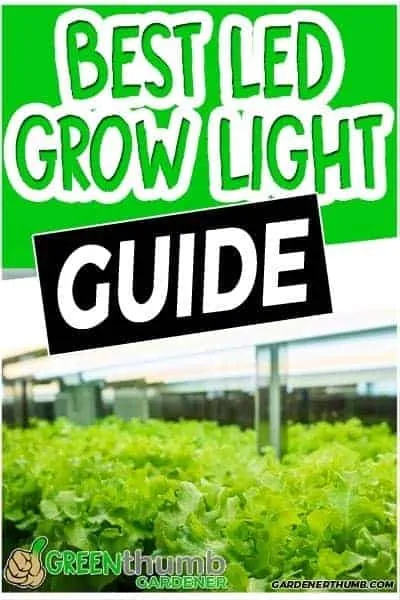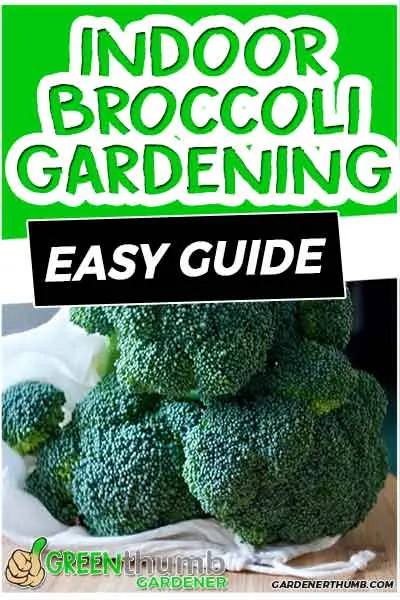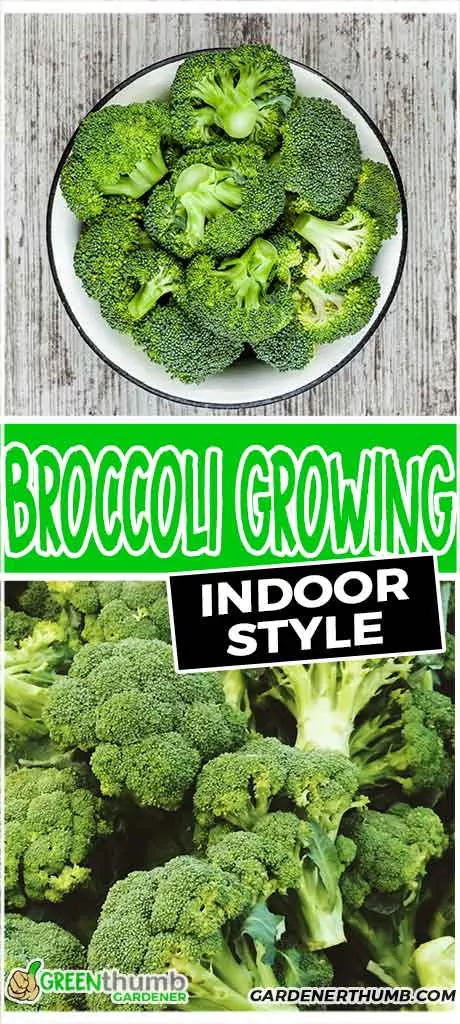Growing Broccoli Indoors Beginner Guide
Last updated: 9/15/20
Little is known about growing Broccoli indoors! This is despite its high popularity in the market.
I am in love with this nutritious vegetable. But every time I went out to buy it from the market, the high costs discouraged me. I knew I had to find a lasting solution to continue enjoying my favorite veggie.
Are you looking out to growing Broccoli indoors? Read on to get experts’ tips and skills to kick-start you.
Green thumb Gardener occasionally links to product and/or services offered by vendors to assist you with all your gardening needs. Some of these may be affiliate links, meaning we earn a small commission if items are purchased.
Want to Download a Garden Hack Guide for FREE

Enter your email below and we will send you a guide to help you SAVE money in your garden.
Growing Broccoli Indoors Levels You Up
You could be a beginner in indoor gardening or have probably engaged yourself in growing other vegetables indoors. Growing broccoli indoors is another string you need to add to your bow.
For your choosing, here are five of my top picks.
Why you need to get acquainted with growing Broccoli indoors
- Broccoli comes with several health benefits
- Broccoli can be pricey in the market. Don’t be limited
- You also get to include the veggie in your diet at your convenience
- With the right procedures, Broccoli can be easily grown and managed indoors
Health Benefits of Broccoli
Broccoli Micro greens Are Very Nutritious
Broccoli has the most vitamin C among the cruciferous cole crops. What does that mean to you?
Right, the vegetable can fight diseases boosting your immune system.
A lot of health benefits have been reported as a result of consuming Broccoli.

Reduces Oxidative Stress
You may experience oxidative stress due to having breathing problems such as asthma or when exercising so hard. Isothiocyanates in Broccoli are effective in reducing this kind of stress.
The chemicals help you absorb oxygen better.
Can Help Prevent Cancer
Most of the cruciferous vegetables are believed to prevent stomach and intestinal cancers. This is because of their rich deposits of isothiocyanate.
For instance, Broccoli has the highest amounts of Sulforaphane, the compound found to reduce the risk of getting cancer. Sulforaphane, together with indole-3-carbinol, may also affect the estrogen level leading to a reduction of the breast cancer risk.
Regulates Blood Glucose
Apart from the prevention of cancer Sulforaphane is also believed to reduce blood sugar levels. This decreases your body’s chances to store fat, consequently reducing the risk of type II diabetes.
Cholesterol Reduction
Broccoli’s soluble fiber can bind with cholesterol found in the blood, making it easier for the cholesterol to be excreted.
Keeps Heart Healthy
Besides reducing the cholesterol level, Broccoli can keep your heart and eyes healthy. Its sulforaphane compounds can also act as an anti-inflammatory, which can help in preventing damage to blood vessels.
It can also help in reversing your blood vessel linings’ damage that could be caused by chronic blood sugar problems.
According to the study done by the Harvard University school of public health, the vitamin B-complex present in these microgreens can help reduce excessive homocysteine.
Homocysteine is an amino acid built up over time after a person consumes red meat. The acids can be controlled by these vitamins reducing the risk of coronary artery disease.
Keeps Eyes Healthy
Are the carrots the only vegetable to improve your eye health? I would be wrong if I believed so. Zeaxanthin present in Broccoli works the same as lutein; the compound in carrot responsible for eye health.
These compounds are excellent in preventing an incurable condition blurring central vision, and clouding the eye’s lens.
Requirements to Grow Indoor Broccoli
There are some requirements you need to focus on to get maximum output from your garden. When it comes to growing your Broccoli indoors, you are in control of the conditions surrounding your vegetables.
With the right practices, you are sure to harvest big. Here is what is required of you for the best results.
Spacing
Most broccoli varieties will grow up to 3 feet tall and 3 feet wide. Spacing majorly depends on two aspects.
Some people prefer starting seeds indoors before transplanting the seedlings to the field. This means they will space the seeds closely before transplanting.
In our case, we will need to use the same spacing for the plants’ entire growth. This will need spacing the plants wisely, depending on the varieties.
Basically, you will require a spacing of 18 to 24 inches within every row and space the rows 24 to 36 inches apart. The large varieties will probably need wider spacing to give room for the maximum broadening of the heads.

If you need to plant your microgreens in containers, you will need to get at least 5 gallons container for every plant. This ensures your plants get enough soil for better root growth and nutrition.
Light
Light is an essential aspect of the better growth of your Broccoli. Add enough grow lights lest your Broccoli grows leggy.
It is recommended to light up your grow room for 14 to 16 hours daily. It would help if you also hung them closer above the seedling. Adjust the lighting, moving them up as your vegetables grow taller.
Soil
Broccoli grows best in slightly acidic soils, having a pH between 6.0 and 6.8. The microgreens will also do best in fertile, well-drained, but reliably moist, and rich organic matter.
This pH and organic matter are vital in ensuring that nutrients such as boron are readily available.
Soil having boron deficiency can cause the growth of hollow stems in your broccoli vegetables. It is also wise to taste your soil for balanced nutrients as too much of a particular nutrient may be toxic to plants.
Fertilizer
Plant growth is majorly affected by the availability of required nutrients in the soil. If you use the correct soil rich in these nutrients, you will need to add less fertilizer.
Nevertheless, you can monitor your plants to ensure that they are growing well. If you are not sure of the level of nutrients in the soil you used, you need to test the soil.
Then start applying fertilizers accordingly as soon as you see the first true leaves. Start by applying a weaker dose of liquid fertilizer, gradually increasing the amount as the seedlings grow.
I found organic compost fertilizer doing best in indoor growing, which you can get in liquid form. Alternatively, you can get tea bags and make your own.
NOTE: Broccoli is a heavy feeder. Ensure you mix compost manure at planting time to give the plant a good start if you don’t want to add too many fertilizers at the growing stages.

Further Reading
Temperature
Broccoli thrives in colder temperatures with the ideal temperature for these vegetables being 55 to 70 degrees Fahrenheit. Temperature above 77 degrees Fahrenheit is too high for the better growth of these microgreens.
The right temperature for germination is 75 degrees Fahrenheit, after which you should keep the temperature lower.
Water
Indoor grown Broccoli will entirely depend on you for water. It is recommended to keep the soil moist. This will be possible with regular watering.
When watering, avoid getting the heads of developing Broccoli wet. Doing so can encourage rot.
Broccoli roots are shallow. This means you should apply a low-pressure watering method such as drip, to avoid disturbing the roots.
Harvesting Your Broccoli
Broccoli grown from seed can take 100 to 150 days to harvest. Broccoli grown from transplants will end up harvesting in 55 to 80 days.
I usually harvest in the morning when the buds are still tight and lush.
Harvest Tips
Most people are interested in the florets. Florets are great and delicious, but if you took good care of your vegetables, the stems would also taste great but milder and sweeter.
With this in mind, you should cut the stem 5 to 6 inches from the head. Leave the plant base with some outer leaves to spur new heads on secondary shoots.
Don’t leave your vegetables to grow past harvesting time. Heads that have started to open and show little yellow flowers are beyond the eating stage.
Final Thoughts
You must be ready now to grow your Broccoli in your grow tent or greenhouse. Whether you want to use containers or grow in the garden, you have the right information to get you started.
The nutritious vegetables full of various benefits could be your next favorite vegetables, flavor for every soup, or many other uses.
Related Questions
1. Can Broccoli be grown indoors?
Yes. With proper provision of essentials for optimum growth such as grow lights, water, proper temperature as well as the use of the right soil, you are good to go.
2. How many heads of Broccoli do you get from one plant?
You can harvest 2 to 3 heads from a single plant over time. When your first harvest, you cut the central head with the stalk at 5 to 6 inches, then the side heads continue to grow so that you can harvest up to 3 months.
3. Is Broccoli easy to grow?
Yes. This is one of the cool-season plants that are easy to grow and maintain maturity.
4. Can you grow Broccoli from a stalk?
No. You can only directly plant Broccoli as seeds to your garden or start them on a bed before transplanting the seedlings.








